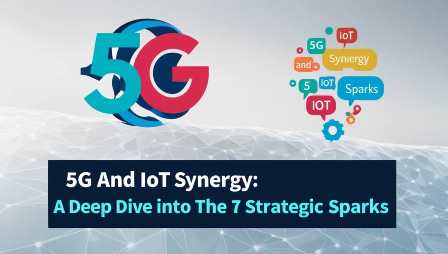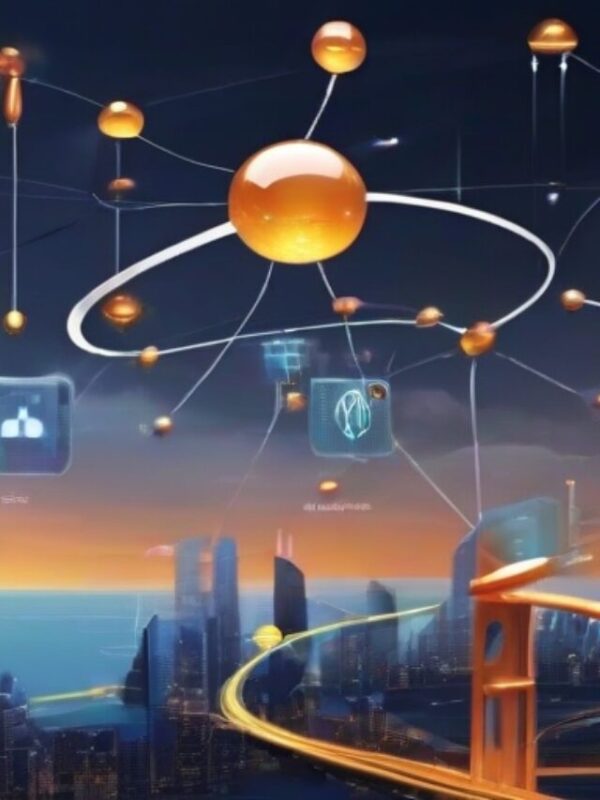5G and IoT Synergy: A Deep Dive into the 7 Strategic Sparks
Within the always-changing terrain of technology, 5G has become a game-changer, transforming our connection, communication, and data consumption.
5G brings about a transforming revolution for the Internet of Things (IoT). This paper will discuss the synergy between 5G and IoT, as well as the seven key sparks driving this technical development.
From 1G to 5G: An atomic leap
- 1 From 1G to 5G: An atomic leap
- 2 How can 5G network technology help IoT?
- 3 IoT in Industry 4.0: A Comprehensive Private 5G Analysis
- 4 Faster, smarter, and connected: 5G’s impact on IoT applications
- 5 Smart City Rise: Networked Megalopolis
- 6 Healthcare 5G IoT Implications:
- 7 Precision farming with 5G IoT
- 8 We simplify networks for many objectives.
- 8.1 What IoT benefits may 5G technology have?
- 8.2 How will 5G affect rural IoT deployment?
- 8.3 Finally, does a 5G IoT connection pose security risks?
- 8.4 Fourthly, is 5G better for IoT in some industries?
- 8.5 Fifth FAQ: How Will 5G Improve IoT?
- 8.6 6. How are 5G IoT devices different?
- 8.7 FAQ 7: How would 5G influence IoT security?
- 8.8 Question 8: How are 5G and IoT related?
- 8.9 Question 9: How can IoT and 5G shape our technological future?
- 8.10 Question 10: Which sector will gain the most from 5G IoT?
- 8.11 Question 11: Which of 5G’s five essential features has the greatest data rates?
1G: The first generation made voice calls using analogue signals, hence launching the mobile communication revolution.
2G: Adding digital signals, 2G offered text messaging and signalled the change to a more data-centric strategy.
3G facilitated mobile internet access, enabling online surfing and accelerated data transmission.
4G The emergence of high-speed internet transformed our online interactions and media consumption.
5G surpasses its predecessors. 5G redefines the whole framework of connection. 5G’s features, such as high-speed internet, minimal latency, and broad device interoperability, have the potential to redefine possibilities across several sectors.
How can 5G network technology help IoT?
1. 5G speeds are record-breaking.
The 5G revolution is unique in its speed. 5G can reach 20 Gbps, making it faster than its predecessor. This increased speed lets IoT devices act as catalysts, increasing user experience.
Faster transmission between 5G IoT devices may reduce latency, which conserves energy. This improved speed may help create a more responsive and energy-efficient IoT ecosystem by enabling real-time data processing.
2. 5G has a 1 millisecond data transmission time.
Real-time communication applications like the Internet of Things depend on this near-instantaneous response time.
Today, latency is a video call or text message delay. 5G latency is 1 millisecond, almost nonexistent. Communicating in real time makes things appear easy.This low latency is amazing for smart devices that must respond quickly and work seamlessly.
3. 5G links several devices simultaneously.
One of 5G’s strengths is its ability to support many devices. 5G can connect one million devices per square kilometer, enabling IoT adoption across several industries.
Consider 5G like the device’s social network. It can now manage one million devices per square kilometer, unlike prior versions. It’s akin to organizing a grand celebration for intelligent devices.
This means more devices can communicate quickly, enabling smart homes and bustling urban infrastructure to work together.We’re extending an invitation to your device to join the most exciting networking event in town.
4. 5G boosts edge computing.
Edge computing brings data processing closer to its source with 5G. Decentralization creates a more adaptable and responsive ecosystem, decreasing cloud server load and improving IoT application efficiency.
Imagine your phone processing some of its data locally in your pocket instead of transmitting it to a server. Edge computing (5G) allows this. 5G accelerates data processing and reduces latency.
It’s like your smartphone has a mini-brain that makes rapid decisions. It improves performance and intelligence in everything from quick gaming to self-driving cars.
5. High security characteristics in 5G.
The increasing IoT ecosystem requires additional security. 5G uses end-to-end encryption and improved authentication to protect infrastructure and IoT data.
Fifth-generation (5G) wireless networks secure devices and handle concerns with improved security.
A reliable, energy-efficient IoT network must protect data transfer and resist cyberattacks. For 5G-enabled IoT devices to succeed, they must balance security and connectivity.
6. Network slicing for your needs:
5G pioneered network slicing, which lets carriers reserve network segments for specialized needs. This optimization adapts the network to different applications, ensuring IoT device connectivity.
Network slicing, one of 5G’s most important features, lets users create their own virtual networks. The IoT design allocates resources efficiently, reducing energy waste.
We can support a lean and energy-efficient IoT ecosystem by adapting network slices to diverse purposes and giving each device the resources it needs.
7. 5G design reduces energy use:
As people become more eco-conscious, 5G provides energy-efficient options. 5G networks aspire to be more energy-efficient than previous generations to meet the rising need for green solutions.
The decreased energy consumption of 5G networks extends the battery life of Internet of Things devices, benefiting consumers and enterprises.
IoT in Industry 4.0: A Comprehensive Private 5G Analysis
5G networks are increasingly essential to current connection solutions, especially those connected to the Industrial Internet of Things.
These specialized networks for industrial applications are revolutionizing speed, reliability, and security.
Private 5G networks for industrial IoT may provide seamless device-equipment connection, creating a responsive and integrated ecosystem.
Sectors may streamline operations, automate, and enhance production with greater networking capabilities.
Private 5G networks for industrial IoT provide a smarter, more adaptable industry. Demand for mission-critical applications and real-time data processing is driving this.
Faster, smarter, and connected: 5G’s impact on IoT applications
Have you considered the benefits of your smart devices? 5G enables smart and fast connections for objects of interest.
Your smart fridge, thermostat, and fitness tracker now communicate. 5G can enable IoT magic. With this technology, your device may download, upload, and talk faster than before.
Instead of connecting, 5G lets your devices sync. No more buffering and waiting. Your statistics say it’s like moving from a backroad to a modern freeway. Speed creates new opportunities and is crucial.
Your smart home becomes smarter, your city gets more efficient, and companies go digital. 5G for IoT applications might revolutionize your electronic life by increasing intelligence, speed, and connection.The significance of 5G IoT devices extends beyond smart cities, healthcare, and agriculture.
The Internet of Things goes beyond gimmicks. The Internet of Things (IoT) is revolutionizing cities, healthcare, agriculture, and other industries. This tour explores how 5G IoT devices are changing enterprises and linking things.
Technology like 5G and the Internet of Things excites us.
The Internet of Things and 5G appear to offer a fresh perspective on our current circumstances, going beyond mere connectivity. Businesses with private networks and healthcare may benefit from 5G.
Smart City Rise: Networked Megalopolis
Imagine a city with excellent public transportation, traffic, and energy consumption. 5G IoT devices are essential for smart city construction. They turn cities into smart, creative hubs using sensors, wireless technologies, and 5G’s lightning speeds.
Healthcare 5G IoT Implications:
5G’s reliable, rapid connection is changing healthcare. Each second counts in this area. 5G IoT devices speed up medical information delivery and remote patient monitoring—personalizing healthcare.
Precision farming with 5G IoT
Farmers are also utilizing AI. Real-time soil sensors and 5G-powered IoT devices allow autonomous agricultural equipment, improving precision and sustainability.The goal of Optus 5G home internet goes beyond connecting devices.
A reliable home internet connection is crucial. With consistently high speeds, Optus 5G Home Internet sets the standard for home internet. Thus, homes may become “smart environments” where conveniences simplify life.
We simplify networks for many objectives.
The IoT is narrowband. NB-IoT is excellent for devices that require high-quality, low-cost connections. NB-IoT enables the connection of smart meters and sensors over long distances with minimal power consumption. The doors open wirelessly.
Wireless technology connects 5G IoT devices, cities, companies, and more.
It goes beyond Wi-Fi. A perfect data-flowing system is the goal. This prepares for a future where 5G IoT devices drive innovation. Progress and growth.
5G IoT devices become more viable as technology advances. We expect the IoT ecosystem to grow, adding more applications, faster speeds, and lower latency.
What IoT benefits may 5G technology have?
First commonly asked question.Consider 5G a highway for your smart devices. From smart homes to citywide networks, everyone benefits from a more streamlined and integrated experience thanks to easier data management.
How will 5G affect rural IoT deployment?
Rural areas are still implementing 5G, but the IoT will greatly benefit. For instance, 5G might revolutionize precision farming by improving crop monitoring and resource allocation.
Finally, does a 5G IoT connection pose security risks?
Security is crucial, and 5G technology boosts authentication and encryption. We employ stringent security procedures to secure the connected devices.
Fourthly, is 5G better for IoT in some industries?
In actuality, 5G Internet of Things applications boost efficiency and innovation in healthcare, manufacturing, and smart cities.
Fifth FAQ: How Will 5G Improve IoT?
5G speeds up technology by connecting more devices at once, reducing latency, and accelerating data transfers.They may be able to communicate faster, last longer on a charge, connect, and enable smart cities and super-responsive technologies.
6. How are 5G IoT devices different?
5G IoT devices have faster data transfer, lower latency, and can connect to many devices at once.
FAQ 7: How would 5G influence IoT security?
5G’s enhanced security protects IoT devices. Smart devices withstand cyberattacks, protecting your data in today’s connected environment.
The Internet of Things (IoT) needs reliable, high-speed connectivity, and 5G gives it.
Question 9: How can IoT and 5G shape our technological future?
When they operate together, 5G and the Internet of Things will change data transmission, networking, and technology in many sectors, including daily life.
Question 10: Which sector will gain the most from 5G IoT?
Smart cities, healthcare, industry, and agriculture may benefit from 5G IoT devices’ efficiency, innovation, and connectivity.
Question 11: Which of 5G’s five essential features has the greatest data rates?
5G’s ultra-fast speeds come from higher-frequency radio waves that can carry more data. Adding lanes to a road allows more vehicles (or data) to go faster, and increasing frequency speeds up your phone’s internet.
Finally, 5G and the Internet of Things are changing technology. 5G’s strategic spark—lightning-fast speeds, low latency, pervasive connectivity, edge computing, enhanced security, network slicing, and energy efficiency—will start an Internet of Things revolution.
This talented team is enhancing our digital experiences and establishing the framework for additional industry breakthroughs. We’re entering a revolutionary moment, and 5G and the IoT might dominate and inspire a flood of innovation that will change how we connect. Allow 5G to change the IoT.
Also Read: Artificial Intelligence and Robotics: Transforming Our World
Also Read: Blockchain Technology: Unlocking the Future of Digital Innovation
Also Read: Cyber Security: Protecting Your Digital World from Malicious Attacks
Also Read: Generative Artificial Intelligence(GenAI)
Also Read: Dive into Deep Learning
Also Read: About OpenAI ChatGPT
Also Read: Recycling Practices Contribute Environmental Sustainability





































